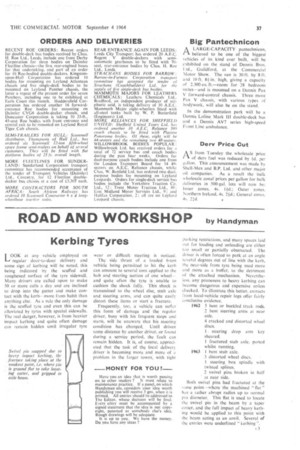ROAD AND WORKSHOP by Handyman
Page 39

If you've noticed an error in this article please click here to report it so we can fix it.
Kerbing Tyres
OOK at any vehicle employed on regular door-to-door delivery and some sign of kerbing will be noted, this being indicated by the scuffed and roughened surface of the tyre sidewall. Many drivers are called upon to make 50 or more calls a day and are inclined to drop into the gutter and make contact with the kerbmore from habit than anything else. As a rule the only damage is the scuffed tyre and even this can be alleviated by tyres with special sidewalls. The real danger, however, is from heavier impact kerbing and quite often damage can remain hidden until irregular tyre wear or difficult steering is noticed.
The side thrust of a loaded 6-top vehicle being permitted to hit the kerb can amount to several tons applied to the hub and steering section of one wheeland quite often the tyre is unable to cushion the shock fully. This shock is transmitted to the wheel disc, stub axle and steering arms, and can quite easily distort these items or start a fracture.
Frequently, too, a vehicle can suffer this form of damage and the regular driver, busy with his frequent stops and starts, will be unaware that his steering condition has changed. Until driven some distance by another driver, or found during a service period, the fault can remain hidden. It is, of course, appreciated that the task of the local delivery driver is becoming more and more of a problem in the larger townS, with tight parking restrictions, and many spaces laid out for loading and unloading are either too small or partially obstructed. The driver is often forced to park at an angle several degrees out of line with the kerb, the near-side front tyre being used more and more as a buffer, to the detriment of the attached mechanism. Nevertheless, any proneness to heavy kerbing can become dangerous and expensive unless checked, To illustrate this better, extracts froin local-vehicle repair logs offer fairly conclusive evidence_
1962 5 bent or buckled track rods.
2 bent steering arms at near side.
4 cracked and distorted wheel discs,
1• steering drop, arm key sheared.
I fractured stub axle, parted whilst running.
1963 1 bent stub axle, 3 distorted wheel discs. steering box spindle with twisted splines, 2 swivel pins broken in half at near side.
Both swivel pins had fractured at the same point—where the machined " fiat" has a rather abrupt radius up to normal pin diameter. This flat is used to locate the swivel pin in the beam by a taper cotter, and the full impact of heavy kerbing would be applied to this point with the beam acting as an anvil. Several of the entries were underlined kerbing ".
































































































































